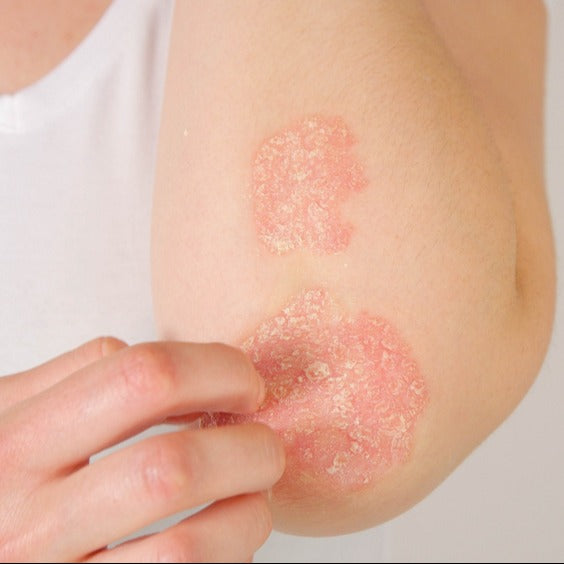
Autoimmune Rash Causes: What You Need to Know for Better Health
Share
An autoimmune rash can be frustrating, uncomfortable, and sometimes alarming, especially when it appears without warning.
Unlike rashes caused by allergies or infections, autoimmune rashes occur when the body’s immune system mistakenly attacks healthy skin cells. This overactive immune response can lead to inflammation, irritation, and sometimes painful or itchy skin eruptions.
Autoimmune rashes are often a visible sign of an underlying condition, making it important to understand their causes and seek proper medical care. By recognizing common triggers and contributing factors, you can take steps toward better management and overall wellness.
What Is an Autoimmune Rash?
An autoimmune rash is a skin reaction linked to an autoimmune disorder — a condition where the immune system targets the body’s own tissues. These rashes may present as red patches, raised bumps, scaly areas, or blister-like lesions, and they can appear anywhere on the body.
Common autoimmune conditions that may cause rashes include:
- Lupus – May produce a butterfly-shaped rash across the cheeks and nose.
- Psoriasis – Often causes thick, scaly patches, commonly on elbows, knees, and scalp.
- Dermatomyositis – Can cause a reddish or violet rash on the face, knuckles, and chest.
- Celiac Disease – Sometimes linked to dermatitis herpetiformis, a blistery, itchy rash.

Common Causes and Triggers of Autoimmune Rashes
While the root cause is an overactive immune response, several factors can contribute to the development or worsening of autoimmune rashes.
1. Genetics
A family history of autoimmune conditions can increase the likelihood of developing an autoimmune rash. Certain genetic markers are linked to specific conditions such as lupus and psoriasis.
2. Environmental Triggers
Sun exposure, pollution, and exposure to certain chemicals can trigger or worsen autoimmune rashes. For example, people with lupus often experience flare-ups after spending time in direct sunlight.
3. Infections
Some bacterial or viral infections can trigger an immune system reaction that results in a rash. In individuals with autoimmune conditions, the immune system may continue to attack even after the infection has cleared.
4. Stress
Chronic stress can disrupt immune function and trigger inflammation, potentially worsening existing autoimmune skin conditions or causing flare-ups.
5. Dietary Factors
For some individuals, certain foods can act as triggers. In celiac disease, gluten consumption can lead to skin rashes as well as digestive issues.
6. Hormonal Changes
Hormonal shifts — such as those that occur during puberty, pregnancy, or menopause — may trigger or exacerbate autoimmune rashes in some individuals.
When to Seek Medical Support
Because autoimmune rashes are often linked to underlying chronic conditions, it’s important to seek medical evaluation if you notice a rash that is persistent, spreading, or accompanied by other symptoms such as fatigue, joint pain, or fever.
A healthcare provider may use blood tests, skin biopsies, or other diagnostic tools to determine the cause. Early diagnosis and treatment can help prevent complications and improve quality of life.

Treatment and Management Strategies
Managing an autoimmune rash often involves treating both the rash itself and the underlying condition.
Treatment may include topical prescription creams or ointments to reduce inflammation and itching, along with oral or injectable medications to help regulate immune system activity.
Lifestyle adjustments, including stress management techniques, gentle skincare routines, and avoiding known triggers, can also play a role in preventing flare-ups.
Additionally, dietary modifications, such as eliminating foods that may cause reactions and focusing on nutrient-rich, anti-inflammatory options, can support overall health and help reduce symptoms.
Supporting Skin and Overall Wellness
Living with an autoimmune rash can be challenging, but with proper care and support, symptoms can often be managed effectively. Focus on:
- Protecting Your Skin – Use gentle, fragrance-free cleansers and moisturizers.
- Sun Protection – Apply broad-spectrum sunscreen daily to prevent flare-ups triggered by UV exposure.
- Reducing Stress – Incorporate practices such as meditation, yoga, or gentle exercise into your daily routine.
- Building a Support Network – Connect with healthcare providers, support groups, or online communities for guidance and encouragement.
You Are Not Alone
An autoimmune rash is a signal from your body that something deeper may be going on. By identifying potential causes and working closely with healthcare professionals, you can take meaningful steps toward relief and better health.
Remember, you are not alone in this journey. With the right care, lifestyle adjustments, and ongoing support, it’s possible to manage autoimmune rashes and maintain a vibrant, healthy life.
References:
- Autoimmune Diseases, https://www.niams.nih.gov/health-topics/autoimmune-diseases
- Autoimmune Skin Disease, https://healthcare.utah.edu/dermatology/services/autoimmune-skin-diseases
- Lupus and the Skin, https://www.lupus.org/resources/how-lupus-affects-the-skin
- Psoriasis Overview, https://www.niams.nih.gov/health-topics/psoriasis
- Dermatitis Herpetiformis and Celiac Disease, https://www.celiac.org/about-celiac-disease/related-conditions/dermatitis-herpetiformis
- Exploring the Causes of an Autoimmune Rash, https://www.citymd.com/health-and-wellness/exploring-causes-autoimmune-rash